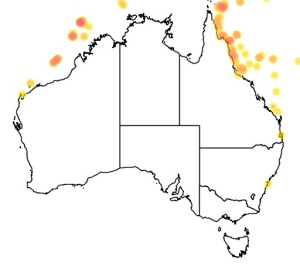Colours
Distinguishing features
A medium sized dark green to brown fish with curved orange lines on the side of the body, a red and blue stripe running back past the mouth, and a black blotch at the base of the tail. Appears dark brown when viewed from more than a few meters underwater. Swims using an undulating motion of the dorsal and anal fins.
Size
- Up to 30 cm (Standard length)
Depth range
- Depth range data is not yet available.
Synonyms
Distribution
Distribution and habitat preferences
Coral rich areas in sheltered lagoonal and back reef habitats.
Found in most reef habitats around the island.
Behaviour
Orangestripe Triggerfishes are found singly or sometimes in loose pairs, roaming slowly over coral rich areas searching for their invertebrate prey. They have powerful jaws with large teeth and can feed on a wide range of food items, including molluscs, crustaceans, worms and echinoderms. This species is considered a keystone species on some Indian ocean reefs due to its impact on sea urchin populations.
At a long term study site on the fringing reef at the northern side of Watson's Bay, this species is consistently found along the outer reef crest zone, whereas the confamilial Hawaiian Triggerfish and Eye-stripe Triggerfish are found in the shallower rubble habitats.
This species is gonochoric and sexually dimorphic, with separate sexes throught the life span and larger males that lose the red and blue cheek stripe. Triggerfishes have demersal eggs which they lay in a benthic nest which is closely guarded by the female for 3-5days until the larvae hatch.
Web resources
References
- Bean, K., G.P. Jones and M.J. Caley (2002). Relationships among distribution, abundance and microhabitat specialisation in a guild of coral reef triggerfish (family Balistidae), Marine Ecology Progress Series, 233: 263-272. LIRS catalog number 90019.
- Bostrom-Einarsson, L., M.C. Bonin, S. Moon and (2018). Environmental impact monitoring of household vinegar-injections to cull crown-of-thorns starfish, Acanthaster spp. Ocean and Coastal Management, 155: 83-89. LIRS catalog number 2202.
- Bray, R.A. and T.H. Cribb (1996). The Australian species of Lobatocreadium Madhavi, 1972, Hypocreadium Ozaki, 1936 and Dermadena Manter, 1945 (Digenea: Lepocreadiidae), parasites of marine tetraodontiform fishes, Systematic Parasitology, 35: 217-236. LIRS catalog number 1007.
- View all references




